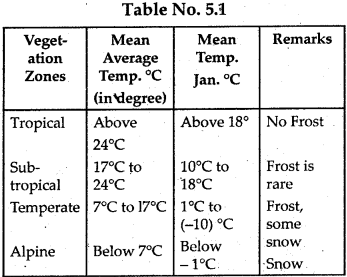NCERT Solutions for Class 9 Social Science Geography Chapter 5 Natural Vegetation and Wildlife
Textbook Exercises
Question 1.
Choose the right answer from the four alternatives given below:
(i) To which one of the following types of vegetation does rubber belong to
(a) Tundra
(b) Tidal
(c) Himalayan
(d) Tropical Evergeen
Answer:
(d) Tropical Evergeen
(ii) Cinchona trees are found in the areas of rainfall more than
(a) 100 cm
(b) 50 cm
(c) 70 cm
(d) less than 50 cm
Answer:
(a) 100 cm
(iii) In which of the following state is the Simlipal bio-reserve located?
(a) Punjab
(b) Delhi
(c) Orissa
(d) West-Bengal
Answer:
(d) West-Bengal
(iv) Which one of the following bio-reserve of India is not included in the world network of bioreserve.
(a) Monas
(b) Dihang-Dibang
(c) Gulf of Mannar
(d) Nanda Devi
Answer:
(d) Nanda Devi
Question 1.
(i) Define an eco-system.
Answer:
Escoystem is meant by the physical environment of a place formed by all kinds of plants, birds and animals of that area.
(ii) What factors are responsible for the distribution of plants and animals in India ?
Answer:
The distribution of plants and. animals are mainly determined by the climate’ of that area. The other determiner factors of this distribution are soil, relief and drainage etc.
(iii) What is biosphere ? Give two examples.
Answer:
A bio-reserve is a place which consists of fairly vast wild land and is devoted to the protection and preservation of flora and fauna of the country in the very natural form.
Examples : Gulf of Mannar, Nilgiri.
(iv) Name two animals having habitat in different types of vegetation.
Answer:
(i) Tropical Rain Vegetation: Elephant, monkey
(ii) Deciduous Vegetation : Lion, tiger
(iii) Thorn-Scrubs : Fox, Lion,
(iv) Temperate Vegetation: Kashmir Stag, Leopard
(v) Alpine-Tundra : Yak, Leopard
(vi) Tidal vegetation: Tiger, turtles
Question 3.
Distinguish between
(i) Flora and Fauna
(ii) Tropical evergreen and deciduous forests.
Answer:
| Flora | Fauna |
| 1. It refers to the plants. | 1. It stands for animal and wild life. |
| 2. It came first into existence | 2. It came into existence after the flora. |
| 3. It can covert energy derived from the sun into food. | 3. It cannot convert sun energy into food. |
(ii) Evergreen and deciduous forests.
Answer:
| Evergreen forests | Deciduous forests |
| 1. These are the forests found in the areas with more than 200 cm of rainfall. | 1. These are found in the areas with 70-200 cm of rainfall. |
| 2. There the trees reach great height upto 60 metre or more. | 2. Trees do not reach at such a height. |
| 3. These are found in Western Ghats and the island groups’ of India. | 3. These are found in the north-eastern states along with the foot hills of Himalayas, Jharkhand and Orissa. |
Question 4.
Name different types of vegetation found in India and describe the vegetation of high altitudes.
Answer:
The major vegetation types of India are the following:
- The Tropical Rain forests.
- The Deciduous forests.
- The Tropical thorn forests arid Scrubs.
- The Temperate forests with Grassland.
- Tine Alpine and Tundra Vegetation.
The vegetation of high altitudes are :
ebony, mahogany and rozewood.
Question 5.
Quite a few species of plants and. animals are endangered. Why?
Answer:
There are about 1300 plant Species and a few animal species are endangered. This is. due to executive exploitation of the plants and animals by man. The other main causes include animal hunting by man for commercial purposes. Pollution due to chemical and industrial waste, acid deposits, introduction of alien species and reckless cutting of the forests to bring land under cultivation and inhabitation, are also responsible for.the imbalance.
Question 6.
Why India has a rich hertiage of flora and fauna?
Answer:
India is one of the 12 mega biodiversity countries of the world. With about 47,000 plant species and 89,000 species of animals, India is tenth in the world and fourth in Asia in plant diversity. There are about 15,00.0 flowering plants in our country which constitute six per cent of the world’s total. India is also rich in non-flowering plants such as finis, algae and fungi and has a huge variety of fish in its fresh marine waters.
India has a rich heritage of flora and fauna. It is due to factors relating to the following:
1. Temperature:
The character and extent of vegetation are mainly determined by temperature along with hurmidity in the air; precipitation and soil. On the slopes of the Himalayas and -the hills of the Peninsula above the height of 915 metres, the fall in the temperature affects the types of vegetation and its growth, and changes it from tropical to subtropical temperate and alpine
Temperature characteristics of the Vegetation Zones

2. Sunlight:
The variation in sun’s radiant energy at different places is due to difference in latitude, altitude/season and duration of the day. Due to the factor of sunlight, trees grow faster in summer.
3. Precipitation:
Almost the entire rainfall is brought in by the advancing south west monsoon (June to Sept.) and retreating north east monsoon. Areas of heavy rainfall have more dense vegetation as compared to other areas.
4. Soil:
Changes in soil conditions have given rise to peculiar types of vegetation in many areas such as mangrove forests, swamps and sandy coastal forests.
5. Relief:
It is another important factor affecting vegetation—plains, plateaus and mountains have different types of vegetation.
These Solutions are part of NCERT Solutions for Class 9 Social Science. Here we have given NCERT Solutions for Class 9 Social Science Geography Chapter 5 Natural Vegetation and Wildlife.